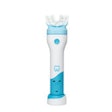
What if there were a way to predict caries onset of caries in seemingly healthy teeth in your pediatric patients before the caries developed? A new study in Cell Host & Microbe from researchers in China and San Diego might show a way to do just that.
By distinguishing between aging- and disease-associated taxa, or groups of organisms, and exploiting the distinct microbiota dynamics between onset and progression, the study authors developed a model they called the Microbial Indicators of Caries. This model was able to diagnose early childhood caries (ECC) from healthy samples with 70% accuracy. This indicator also was able to predict, with 81% accuracy, future ECC onset for samples "clinically perceived as healthy."
Age-dependent microbiota development is altered by ECC onset, and shifts in oral microbiota occur before manifestation of clinical symptoms of ECC, the authors concluded. Thus, caries onset in apparently healthy teeth can be predicted using microbiota, when appropriately detrended for age.
"Intriguingly, during ECC development, the most profound change in the oral microbiota took place at ECC onset rather than during ECC progression," the authors wrote (Cell Host Microbe, September 9, 2015, Vol. 18:3, pp. 296-306). The research team was led by Fei Teng from the department of operative dentistry and endodontics at Sun Yat-sen University Guanghua School and Hospital of Stomatology in China, and the co-authors were from various institutions in China and the departments of pediatrics and computer science and engineering at the University of California, San Diego.
Plaque and saliva
The oral microbiome is defined as the "microorganisms found in the human oral cavity," according to a 2010 article in the Journal of Bacteriology (October 2010, Vol. 192:19, pp. 5002-5017). They are also known as oral microflora or oral microbiota.
In the current study, researchers sampled the plaque and saliva microbiota from 50 children who were about 4 years old at the beginning of the two-year study period. The samples were collected at four time points over the two years (six months between the first three measurements and a year after the third). The researchers collected a total of 284 samples. At a given time, microbiota with no decayed, missing, or filled surfaces (DMFS) were designated as healthy; those with caries were classified as low caries (1 ≤ DMFS < 6) or severe caries (DMFS ≥ 6).
“These findings ... underscore the advantages and potential of oral microbiota as disease biomarkers in human populations.”
The children were classified into one of three groups, depending on any change of caries state over the two years. The "stay healthy" group contained 17 children with 94 samples, with DMFS remaining zero throughout the study. The caries-onset group contained 21 children who provided 120 samples. These patients transitioned from a healthy to a caries-active state. The third group was the caries-progression group. The 12 children with 70 samples started with caries and evolved into an exacerbated disease state.
To test their theory that the Microbial Indicators of Caries model would be able to diagnose ECC accurately, the researchers used the model to predict whether a subject with a DMFS of 0 (known in the study as the "relative health" group) would develop caries. When applied to 42 samples in this group (21 samples in plaque and 21 in saliva), 17 (81%) of the plaque samples were correctly predicted as caries. For the saliva samples, 11 were correctly predicted. The authors noted this discrepancy and that it suggested a higher accuracy for plaque than saliva for predicting ECC onset.
For the caries-onset group and overall microbial structure, the authors reported that the effect of ECC onset on bacterial diversity was more important than that of age. This suggested to them that the health-to-caries shift in the oral microbiota can be distinguished from the "normal" variation attributed to host aging.
The authors recommended that the age factor should be taken into account when modeling ECC development. They also found that host variation did not affect the bacterial diversity in the caries-onset group, which suggests that oral microbiota can serve as a proxy for tracking ECC onset of human populations in this age range.
Developmental dynamics
"These findings, together with observations that the effect sizes of both caries and gingivitis are greater than host variation in oral microbiota, underscore the advantages and potential of oral microbiota as disease biomarkers in human populations," the authors wrote.
As previous studies have noted that oral microbiota can change over time, the authors suggest that the "developmental dynamics of oral microbiota can potentially respond to host development or maturation."
The authors noted that the Microbial Indicators of Caries model allows collection of plaque or saliva at the patient's home, so it could possibly serve as an "objective, sensitive, and patient-friendly measure of ECC susceptibility" and contribute to preventive intervention of ECC and cross-study evaluation of oral care products in pediatric populations.



















